Office of the President
“I am honored to serve as the 13th president of The College of St. Scholastica,” McDonald said. “I am proud to work alongside our outstanding students, faculty, and staff as we move the College forward to a bright future.”
Dr. Barbara McDonald became St. Scholastica’s 13th president on Aug. 5, 2019.
Dr. McDonald came to St. Scholastica from North Hennepin Community College in Brooklyn Park, MN, where she had served as president since 2015. Her career in higher education includes extensive experience in teaching, scholarship, administration, and international education.
McDonald’s inauguration ceremony was held on Feb. 10, 2020.
Biography
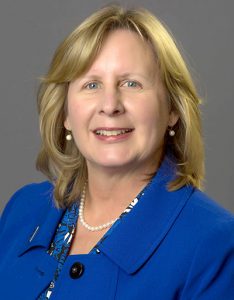
Dr. McDonald’s career in higher education includes extensive experience in teaching, scholarship, administration, and international education. She came to St. Scholastica from North Hennepin Community College (NHCC) in Brooklyn Park, MN, where she had served as president since 2015. McDonald retired from the Minnesota State system in August 2019, after 22 years of service.
During her tenure with the Minnesota State system, Dr. McDonald also served as interim president of Minnesota West Technical and Community College in Worthington, MN, from 2014 to 2015. From 2000 to 2014 she served in various leadership roles in academic and student affairs at Itasca Community College in Grand Rapids, MN, where she was promoted to provost. From 1997 to 1999, she served at Rainy River Community College in International Falls, MN, filling the roles of faculty and assessment and service learning coordinator. She was an adjunct faculty member in the Master of Education Cohort Program at the University of Minnesota-Duluth’s Extension Program in 1999.
McDonald was born and grew up in Beirut, Lebanon and earlier in her adult career, she and her family lived and worked abroad for many years in Africa, Europe, the Middle East, and Asia. McDonald specialized in teaching English as a Second Language. She was the ESL Program Director and ESL Instructor at the Western Academy of Beijing in Beijing, China from 1995 to 1997, and served as an ESL Consultant in Manila, Philippines and Johannesburg, South Africa from 1989 to 1994. Between 1986 and 1989 she held ESL faculty positions at Yonsei University in Seoul, South Korea, at Central Texas College on the U.S. Military Base in Seoul, and at the American University in Cairo, Egypt.
While with the Minnesota State system, McDonald was a member of the Leadership Council and served on the Executive Leadership Committee, the Chancellor’s Transition Team, and several statewide committees. McDonald also chaired the presidential search committee for Lake Superior College in Duluth in 2018-19.
She is an actively engaged community member, currently serving with the Arrowhead Growth Alliance of Duluth, on the Board of Minnesota Campus Compact, and as an Advisory Board member of the Center for Innovation and the Arts. She has also served on the Itasca Economic Development Board, the Grand Itasca Hospital and Clinic Board, the Reif Performing Arts Board, Twin West Chamber Foundation Board, the North Hennepin Chamber Board, the Brooklyn Bridge Alliance for Youth, and the Minnesota Learning Network Board — University of Minnesota and Minnesota State. A Catholic, she also served on the Parish Council of St. Joseph’s Catholic Church in Grand Rapids, MN.
McDonald earned a Doctor of Education (Ed.D.) from the University of Minnesota-Twin Cities in 2002 and a Master of Arts in Teaching English as a Foreign Language from American University in Cairo, Egypt, in 1983. She started her undergraduate journey at The College of St. Scholastica and finished with a Bachelor of Arts in English from the University of Colorado-Boulder in 1980.
From the Office of the President
Read updates and news about The College of St. Scholastica from President McDonald.
Past Presidents
Colette McCarrick Geary, PhD 2016-2019
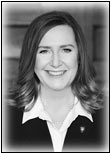 After taking the helm of St. Scholastica on July 1, 2016, President Colette Geary provided strong leadership and collaborative decision-making that left the College financially stable and poised to move forward with a variety of innovative plans. With input from faculty and staff, she successfully launched a thoughtful strategic planning process that will shape the College’s priorities for the next several years. She took concrete steps to fulfill the College’s inclusive excellence goals, including appointing former Obama administration official Karen Diver to the newly created position of Faculty Fellow for Inclusive Excellence. She led the completion of two major capital projects, renovations to Somers Hall and the Science Center nursing labs, that will benefit students for decades. Meanwhile, she has nurtured and strengthened the College’s partnership with its sponsors and founders, the Benedictine Sisters of St. Scholastica Monastery, while enhancing the College’s relationship with the Duluth Diocese.
After taking the helm of St. Scholastica on July 1, 2016, President Colette Geary provided strong leadership and collaborative decision-making that left the College financially stable and poised to move forward with a variety of innovative plans. With input from faculty and staff, she successfully launched a thoughtful strategic planning process that will shape the College’s priorities for the next several years. She took concrete steps to fulfill the College’s inclusive excellence goals, including appointing former Obama administration official Karen Diver to the newly created position of Faculty Fellow for Inclusive Excellence. She led the completion of two major capital projects, renovations to Somers Hall and the Science Center nursing labs, that will benefit students for decades. Meanwhile, she has nurtured and strengthened the College’s partnership with its sponsors and founders, the Benedictine Sisters of St. Scholastica Monastery, while enhancing the College’s relationship with the Duluth Diocese.
Larry Goodwin, PhD 1998-2016
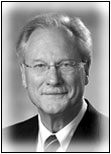
Larry Goodwin earned a PhD in theology from the University of Chicago. He joined St. Scholastica in 1987, serving as dean of faculty and vice president of academic affairs before being named interim president in early March 1998. After a nationwide search he was inaugurated as the private college’s 11th president in October 1999.
During Goodwin’s presidency, enrollment more than doubled, from 2,040 in 1998 to 4,235 in 2016, with major strategic growth in graduate, online and nontraditional adult student markets. The number of academic programs rose from 49 to 64. Study-abroad programs rose from three in 1998 to ten. Construction included Mars Lakeview Arena, Cedar, Kerst and Scanlon residence halls, Burns Wellness Commons academic and wellness complex, enlargement of the Science Center including a biochemistry wing, Benedictine Commons gathering space, and two campus tunnels, and the Health Science Center at BlueStone.
Daniel H. Pilon, Ed.D. 1981-1998
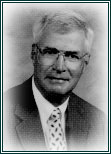 Dr. Dan Pilon, who served as president only one year less than Mother Agnes, completed many projects in his seventeen years as president. In his tenure of office, the Encore program for non-traditional age students was born and flourished, bringing a large number of mature students to campus. The Management program was added, as were several graduate-level programs as the College became accredited to offer Masters degrees. The student union in Tower Hall was renovated, the library-chapel renovation project was carried out, resulting in a trebling of library space, Willow, Birch and Maple apartments were constructed as was an additional wing on Somers Hall. The sisters built their own residence adjacent to Stanbrook Hall and the College was able to claim all of Tower Hall, which was renovated to add more classrooms and offices. The façade of the Little Theater was rebuilt to provide handicapped access, and a new garage was built. The Mitchell Auditorium was constructed, funded by a capital campaign, and a third floor addition was added to the Science Building to house Nursing offices and additional classrooms.
Dr. Dan Pilon, who served as president only one year less than Mother Agnes, completed many projects in his seventeen years as president. In his tenure of office, the Encore program for non-traditional age students was born and flourished, bringing a large number of mature students to campus. The Management program was added, as were several graduate-level programs as the College became accredited to offer Masters degrees. The student union in Tower Hall was renovated, the library-chapel renovation project was carried out, resulting in a trebling of library space, Willow, Birch and Maple apartments were constructed as was an additional wing on Somers Hall. The sisters built their own residence adjacent to Stanbrook Hall and the College was able to claim all of Tower Hall, which was renovated to add more classrooms and offices. The façade of the Little Theater was rebuilt to provide handicapped access, and a new garage was built. The Mitchell Auditorium was constructed, funded by a capital campaign, and a third floor addition was added to the Science Building to house Nursing offices and additional classrooms.
Bruce W. Stender, PhD 1975-1981
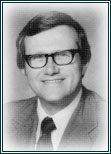 Dr. Bruce Stender and the Board of Trustees carried out the first capital campaign, “The Scholastica Adventure,” which brought in $8.2 million. It was during his tenure that a new general education program involving institutional competencies was inaugurated, the Reif Recreation Center was constructed, the former gymnasium was converted to a theater and the Irish Study Center was created at Louisburgh, in County Mayo. In October 2019, the Stender School of Business and Technology was named in honor of Dr. Stender’s many contributions to the College.
Dr. Bruce Stender and the Board of Trustees carried out the first capital campaign, “The Scholastica Adventure,” which brought in $8.2 million. It was during his tenure that a new general education program involving institutional competencies was inaugurated, the Reif Recreation Center was constructed, the former gymnasium was converted to a theater and the Irish Study Center was created at Louisburgh, in County Mayo. In October 2019, the Stender School of Business and Technology was named in honor of Dr. Stender’s many contributions to the College.
Sister Joan Braun, OSB, Interim President 1974-1975
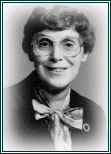 At the time of Father Shea’s sudden resignation, Sister Joan assumed the duties of interim president. During her tenure, WSCD-FM began broadcasting from studios in Tower Hall. Another presidential search was begun.
At the time of Father Shea’s sudden resignation, Sister Joan assumed the duties of interim president. During her tenure, WSCD-FM began broadcasting from studios in Tower Hall. Another presidential search was begun.
The Rev. Francis X. Shea, S.J. 1971 – 1974
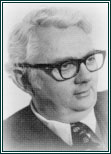 Father Frank Shea came to the College from Boston with the intention of putting the College on the map both locally and nationally. He brought the College to the attention of the local community as something other than “the convent school on the hill.” His ebullient personality charmed them down at the Rotary Club. He established the first varsity sports team–men’s hockey-built the Grove and Pines apartments, and oversaw the institution of a new curricular plan: the Winton Plan. Programs in Media Studies, Indian Studies and Physical Therapy were introduced.
Father Frank Shea came to the College from Boston with the intention of putting the College on the map both locally and nationally. He brought the College to the attention of the local community as something other than “the convent school on the hill.” His ebullient personality charmed them down at the Rotary Club. He established the first varsity sports team–men’s hockey-built the Grove and Pines apartments, and oversaw the institution of a new curricular plan: the Winton Plan. Programs in Media Studies, Indian Studies and Physical Therapy were introduced.
Sister Mary Richard Boo, O.S.B. 1967 – 1971
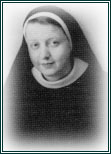 A number of innovative curricular programs were instituted under Sister Mary Richard’s leadership. The Education Department reorganized all of its course offerings to stress individualized instruction and a new general education curriculum was planned. Upon the closing of its high school many of the Priory offices and general living spaces were moved into Stanbrook Hall, giving the College more room. In 1969, the College officially became coeducational. The Lay Advisory Board was reorganized into the Board of Trustees with the accompanying responsibility of governance of the College. Their first task was to carry out a national search for a new president.
A number of innovative curricular programs were instituted under Sister Mary Richard’s leadership. The Education Department reorganized all of its course offerings to stress individualized instruction and a new general education curriculum was planned. Upon the closing of its high school many of the Priory offices and general living spaces were moved into Stanbrook Hall, giving the College more room. In 1969, the College officially became coeducational. The Lay Advisory Board was reorganized into the Board of Trustees with the accompanying responsibility of governance of the College. Their first task was to carry out a national search for a new president.
Sister Ann Edward Scanlon, O.S.B. 1960 – 1967
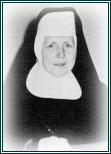 Under Sister Ann Edward’s leadership, a new period of building began. In order to move the student bedrooms out of Tower Hall, it was decided to build a separate dormitory. This necessitated the College becoming separately incorporated from the religious community in order to qualify for federal loans. Somers Hall was completed, a gift from the Ridder family made possible the renovation of the library stacks, and planning for a new science building was begun.
Under Sister Ann Edward’s leadership, a new period of building began. In order to move the student bedrooms out of Tower Hall, it was decided to build a separate dormitory. This necessitated the College becoming separately incorporated from the religious community in order to qualify for federal loans. Somers Hall was completed, a gift from the Ridder family made possible the renovation of the library stacks, and planning for a new science building was begun.
Sister Joselyn Baldeschweiler, O.S.B. 1958 – 1960
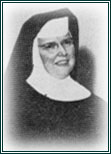 Sister Joselyn, a member of the College English department, was the person chosen by Mother Martina to head the College as its first non-prioress president. In her brief tenure, Sister Joselyn chose to eliminate the Business Education program (office skills such as typing and shorthand preparing young women for secretarial duties) as incompatible with the ideal of a liberal arts college.
Sister Joselyn, a member of the College English department, was the person chosen by Mother Martina to head the College as its first non-prioress president. In her brief tenure, Sister Joselyn chose to eliminate the Business Education program (office skills such as typing and shorthand preparing young women for secretarial duties) as incompatible with the ideal of a liberal arts college.
Mother Martina Hughes, O.S.B. 1954 – 1958
 During her tenure of office, Mother Martina realized that for a single person to hold the office of both Prioress and President of the College was not only a heavy responsibility, but also that a person who might be elected prioress would not necessarily always be qualified to head an institution of higher learning. She therefore separated the two positions.
During her tenure of office, Mother Martina realized that for a single person to hold the office of both Prioress and President of the College was not only a heavy responsibility, but also that a person who might be elected prioress would not necessarily always be qualified to head an institution of higher learning. She therefore separated the two positions.
Mother Athanasius Braegelman, O.S.B. 1942 – 1954
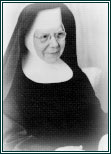 Mother Athanasius continued Mother Agnes’ policies, and under her leadership programs in Elementary Education and Physical Education were added. She established the Lay Advisory Board, the forerunner of our present Board of Trustees.
Mother Athanasius continued Mother Agnes’ policies, and under her leadership programs in Elementary Education and Physical Education were added. She established the Lay Advisory Board, the forerunner of our present Board of Trustees.
Mother Agnes Somers, O.S.B. 1924 – 1942
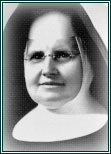 It was at the beginning of her term as the fifth Prioress that the College of St. Scholastica became a four-year institution. At that time, the prioress was also the president of the College. Mother Agnes, known to later members of the community as “the Builder” presided over the construction of the northeast wing of Tower Hall, of Stanbrook Hall, the College library and Our Lady Queen of Peace Chapel. Under her leadership, programs in the fine arts and in health professions such as Nursing, Medical Records, Medical Technology and Dietetics were begun. Mother Agnes felt it to be the responsibility of the College to provide an artistic environment for its students which would educate them to be cultured women of refinement. She collected examples of fine furniture, paintings and objets d’art to this end. Her eighteen years in office as both Prioress and President make her the president with the longest tenure.
It was at the beginning of her term as the fifth Prioress that the College of St. Scholastica became a four-year institution. At that time, the prioress was also the president of the College. Mother Agnes, known to later members of the community as “the Builder” presided over the construction of the northeast wing of Tower Hall, of Stanbrook Hall, the College library and Our Lady Queen of Peace Chapel. Under her leadership, programs in the fine arts and in health professions such as Nursing, Medical Records, Medical Technology and Dietetics were begun. Mother Agnes felt it to be the responsibility of the College to provide an artistic environment for its students which would educate them to be cultured women of refinement. She collected examples of fine furniture, paintings and objets d’art to this end. Her eighteen years in office as both Prioress and President make her the president with the longest tenure.

